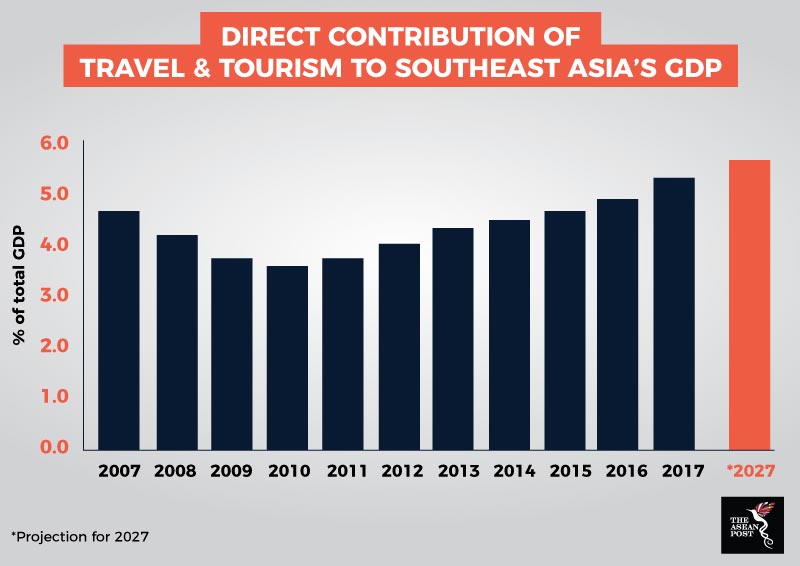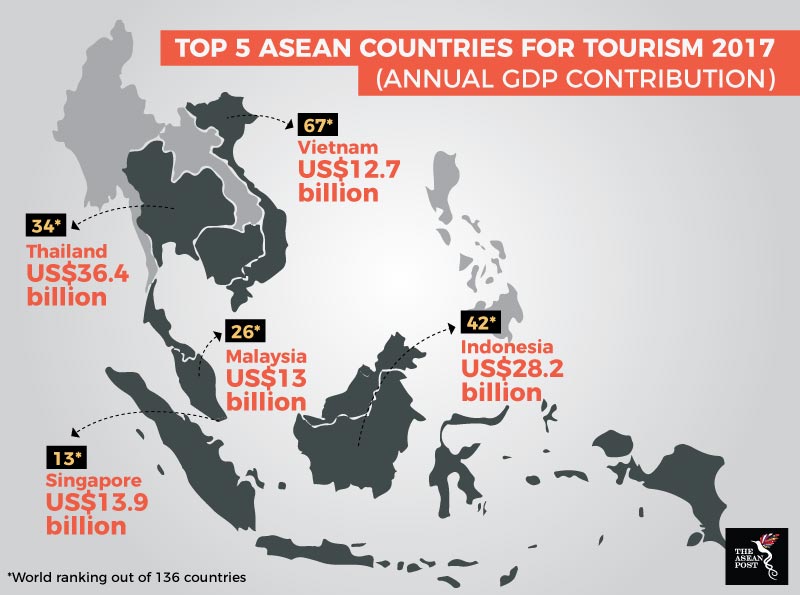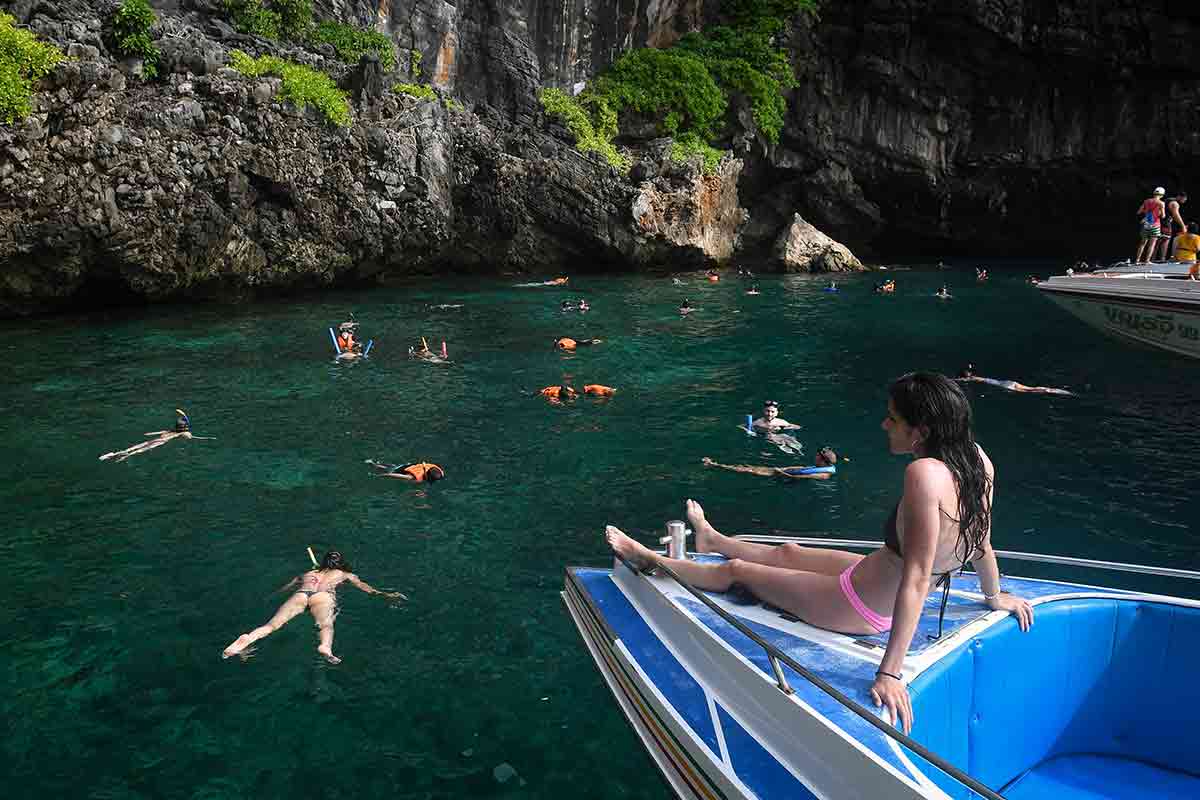The unique and diverse range of recreational activities and travel options in this region has made Southeast Asia a top destination for tourists. According to the World Tourism and Travel Council (WTTC), the tourism sector alone directly contributed a whopping US$119.7 billion in 2016 to the region’s coffers and this amount is projected to rise to US$222.8 billion in 2027, which makes up 5.3 percent of total gross domestic product (GDP) for the region.
Since tourism is one of the main growth-generating sectors for Southeast Asia, it is important that the Association of Southeast Asian Nations (ASEAN) remains on the ball when it comes to growing and developing this sector.
According to the ASEAN Tourism Strategic Plan 2016-2025, the regional bloc has pledged that by 2025, it would “be a quality tourism destination offering a unique, diverse ASEAN experience, and will be committed to responsible, sustainable, inclusive and balanced tourism development, so as to contribute significantly to the socioeconomic well-being of ASEAN people.”
Staying true to this pledge, the 21st Meeting of ASEAN Tourism Ministers that was held in January 2018 in conjunction with the ASEAN Tourism Forum (ATF) 2018, saw the adoption of a number of new declarations along with associated plans to boost and complement their current strategic plan. These include developing ASEAN tourism products, enhancing connectivity and expanding the ASEAN regional destination-marketing programme.
Source: World Travel and Tourism Council
Current plans
Developing ASEAN tourism products has been in the pipeline since 2016. In the recent meeting, the Tourism Ministers emphasised the need to expand ASEAN tourism products through collaborative arrangements with partners, and they were pleased to note the development of new ASEAN Tourism Packages involving the private sector, which would feature more than 130 tourism products covering multi-ASEAN destinations.
The ministers also realised the importance of targeting gastronomy as a key driver to achieve inclusiveness in tourism. This resulted in a Joint Declaration on Gastronomy Tourism, aimed at establishing the region’s gastronomy platform for knowledge sharing to substantially expand ASEAN gastronomic experiences.
In terms of enhancing connectivity for tourism, an ASEAN Framework Agreement on the Facilitation of Cross Border Transport of Passengers by Road Vehicles (CBTP) was signed. This framework will facilitate the unified cross-border mobility of tourists and will promote overland travel between ASEAN member states.
Another plan in the works is the collaboration between five ASEAN member states – Cambodia, Lao PDR, Myanmar, Thailand and Vietnam – and China in the formation of the Lancang Mekong Tourist Cities Cooperation Alliance.
Speaking at the working meeting in Kunming on 17 November 2017, U Yee Mon, standing secretary of Myanmar Ministry of Hotels and Tourism, said that tourism cooperation among the Mekong cities will be able to create more job opportunities and enhance the awareness of respecting the exchange of cultural traditions.
“Sharing a river, countries along the Mekong should jointly create a better future,” he stated. Source: Travel and Tourism Competitiveness Report 2017
Source: Travel and Tourism Competitiveness Report 2017
Cruising on new plans
The Tourism Ministers have also adopted the ASEAN Declaration on Cruise Tourism. According to the Declaration, ASEAN is supporting the aim to further develop and fortify cruise tourism due to the sustained economic growth generated by the cruise tourism industry in the region.
One good example would be the growth of the cruise industry in Singapore. According to the latest data from the Singapore Tourism Board (STB), the Republic's cruise industry directly contributed SG$706 million to the country's economy in 2016, a 36 percent increase from 2010.
Through the implementation of this declaration, the industry hopes to see 4.5 million passengers cruising in Southeast Asia by 2035, 10 times more than in 2016.
Inclusive tourism
Moving forward with the current theme for ASEAN tourism – “Accessible Tourism for All” – ASEAN would need to steer toward the direction of inclusive tourism. The goal of an inclusive tourism sector can only be achieved when ASEAN overcomes certain challenges, especially in less developed parts of the region.
Some challenges that were highlighted in the ASEAN Tourism Strategic Plan 2016-2025 include weak policy frameworks for mainstreaming sustainable tourism development and a lack of prioritisation of tourism in public infrastructure investment.
In order to overcome these challenges and maintain Southeast Asia as a highly sought-after tourist destination, member states must invest more in tourism infrastructure to further realise and maximise their market potential. This can be done by catering to the needs of all tourists, in and out of the region, including the disabled and senior citizens, women and children.
This article was first published by The ASEAN Post on 30 January, 2018 and has been updated to reflect the latest data.
